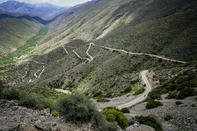Die Hel
The story of this Little Karoo valley, which is really named Gamkaskloof, is quite amazing. When General Smuts’ commando was sneaking through the Cape mountains, they came across a community in a steep valley totally isolated from the outside world.

The people of the valley had sought escape from British rule, but instead of joining the Voortrekkers heading north, they retreated here.
A road was finally built into the kloof in the 1960s, and as well as letting the modern world slowly creep in, it allowed the younger people to trickle out. By the 1990s, no one was left, so CapeNature took it over to protect the natural environment as well as the old homes in the valley, which are now guest cottages. Oh, did I mention the road? It's about 40 km long, descending from the summit of Swartberg Pass, but it’s likely to take several hours to negotiate.
The road to Die Hel (and back) is not only a road to nowhere, it's as far off the beaten track as you can get. It seems like an unnecessarily long 50-odd-km to get to Gamkaskloof, routed as the road is from Swartberg Pass, when it is less than 20 km from Seweweekspoort, but the factor that decided which route to cut was the rock.
The rock on the western (Seweweekspoort) side of the kloof is hellishly hard quartzitic sandstone, while that on the eastern (Swartberg Pass) side is much softer sandstone and shale. The road engineer chose the softer route, geologically speaking, but it is very much harder than the alternative would have been in terms of driving. In any event, the creation of a road at all opened in 1962 - ended a way of life in the kloof that had gone unnoticed for more than a century.
 Many a rider has braved the Swartberg Pass en route to Gamkaskloof, and once past the poort on the Prince Albert side, a war of attrition wi...
Many a rider has braved the Swartberg Pass en route to Gamkaskloof, and once past the poort on the Prince Albert side, a war of attrition wi... Hidden inside a narrow valley, folded away within the Swartberg Mountain massif, is Gamkaskloof. Literally, this translates as ‘Lion’s R...
Hidden inside a narrow valley, folded away within the Swartberg Mountain massif, is Gamkaskloof. Literally, this translates as ‘Lion’s R...